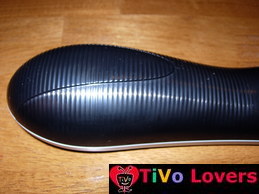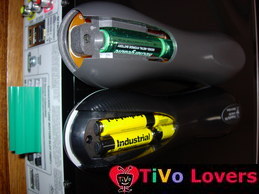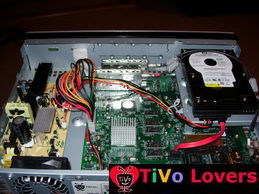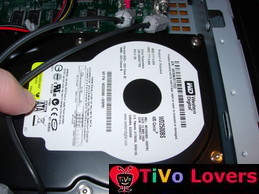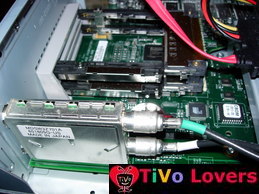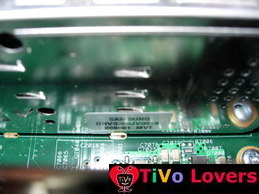In The Beginning
Copyright © 2006 MegaZone
If you’re looking for quick answers to your Series3 questions, read this review later – head over to the Series3 FAQ first! And if you’re just eager to see the unit, check out the 195 companion photos.
This all started on Wednesday, August 9th, when I received an email from Bob Poniatowski, aka TiVoPony, asking me to give him a call. No fool I, I called him immediately and he explained that they were sending out Series3 review units to the press and the like, and they were also looking for people from the blogosphere to do reviews. Would I be interested in doing a review? Well, I managed to avoid doing my best Freakazoid! impression and shouting “WOULD I EVER!”, but that’s what I was thinking. A chance to get my hands on a Series3 and really check it out before its release? There is no way I’d turn that down. If not for the pesky non-disclosure agreement and such, they may as well have just shipped me a box with a note saying “Review this, and don’t talk about it until September 12th.”So Pony passed my information on to the folks handling the review distribution, and on Tuesday, August 15, I received an email from Krista Wierzbicki with the program information and the paper work I needed to fill out. You know, promising my soul to TiVo if I said a word about the Series3 before the NDA was lifted. The surprising part, to me, was the date – the aforementioned September 12th. I’ve been saying, for a while now, that I expected the box to be out in October, maybe early November. So I thought I’d have more time to play with it to do the review. It was clear things were coming sooner, not that I have any complaints about that.
Now, there was one issue. I didn’t own an HDTV. 100% of my television viewing is time-shifted, so there was never a point in having HDTV without a decent way to time-shift it. (I’ve seen the cable DVRs, note I said ‘a decent way’.) So I’ve been waiting for the Series3 to make the switch to HD. I figured the longer I waited, the better sets got and the lower the prices dropped. Now, suddenly, I have good reason to upgrade. So, starting just after my conversation with Pony, I dove back into HDTV research to find a set. Fortunately I’ve been keeping loose tabs on the market in preparation for the Series3, so I wasn’t going in cold. On Monday, August 14th, I ordered a Samsung HL-S6187W, a 61″ 1080p DLP set. While I was waiting for it to be delivered, I starting out on my 12 year old, 32″ Panasonic CRT. But, hey, it gave me a reason to play with the S3 (I felt silly typing out ‘Series3′ all the time) in a couple of different configurations.
On Friday afternoon, August 18th, the UPS man brought me a present at work. A large, plain white box from TiVo. Inside was the new S3 packaging – a sharp, black box that will certainly set it apart from the bright Series2 boxes. Along with the unit was some literature for reviewers, and that gave me my first surprise. The S3 is THX certified. The first, and only, DVR to be so certified. Oh, sorry, that’s another thing. The S3 is not a ‘DVR’, it is a ‘DMR’ – Digital Media Recorder. The change in nomenclature reflects the shift to not only televised content, but broadband content and other forms of media. Yeah, OK, so we’re all still going to call it a DVR. Unfortunately, I was at work, so I had to put the box aside. It sat there, taunting me, for the rest of the day.
Oh, I’m sure you’ve probably heard by now if you’re reading this review, but the MSRP on the S3 is $799.99. That’s not pocket change, but it is a quality product. Service pricing is the same as with the S2. Currently you can pre-pay for one year for $155.40, two years for $299, or three years for $299 – which is a special price. Normally that’s $399. Monthly remains $12.95, and the $6.95/month Multi-Service Discount (MSD) also applies to the S3.
First Impressions
I know I’ll probably lose geek points for this, but I actually started out by reading the enclosed literature before I unpacked the unit. I wanted to see what they had to say to reviewer’s before I dove in.
First things first – the name of the product is the “TiVo® Series3â„¢ HD Digital Media Recorder”. Just the ‘Series3′ for short, or the S3 for shorter. As I mentioned above, the S3 is “the world’s first and only THX certified DVR”. That was a surprise to me, and a nice one.
There were some not-so-nice surprises in the documentation, however. I’ll talk about those below.
The packaging for the S3 itself is nicely executed. I think the understated black box befits a high end component like the S3. I know, that’s completely subjective. But somehow I feel the bright orange, cheerful Series2 packaging just wouldn’t be right for the Series3. This is TiVo dressed up for a fine night out.
Inside the box there is the smaller box with the documentation, remote, and the cables. Right on top is the guide for installing CableCARD, to make it easier on your installer. (Or yourself if you’re lucky enough to live somewhere where they allow self-install.) There is also a Series3 version of the quick-start poster that has been included with the S2 for a while. One side for those with digital cable, the other for those without. And, of course, the S3 Viewer’s Guide.
The Cables
There are two bags of cables included with the unit – “HD Video Cables” and “Basic Cables”. The HD bag holds component video cables and an HDMI cable. The basic bag holds the power cable, a phone line, phone splitter, composite A/V cable, and coaxial RF cable.
I was very slightly disappointed that they didn’t include an optical audio cable or an S-Video cable. Well, S-Video not so much, but I do think they should include an optical cable. Considering a lot of people are going to be connecting this HD box to HD sets without HDMI, most likely with component cables, the optical audio cable would give them everything they need to connect it with the best video and audio ‘out of the box’. Even those using HDMI may want optical to feed an audio receiver for surround sound. Considering the high end market for this box, and the high price, a few dollars for an extra cable isn’t much to ask. Note I did say ‘very slightly disappointed’, I don’t think this is a big deal. But it’d be nice.
The Remote
The remote looks much like the prototype displayed a CES2006, with improvements. Unlike the prototype, the production remote does have the DVR 1-2 switch to control multiple units. The colors have also been changed slightly, while the prototype had light grey buttons the production model is all black. While the prototype had 4 distinct directional buttons and a select button in the middle, the production remote has a circular directional pad with a central select, aka a 5-way navigator familiar to many PDA users, etc. The pad is larger than the 4-way d-pad on the S2 remote, making it easier to use. The thumb buttons have also been de-emphasized, sliding down the remote while the volume and channel controls have been moved up to be closer to the top of the remote. I think that makes sense, you use volume and channel much more than thumb buttons.
The remote is roughly the same size as the current S2 remote. You can see it compared to the remote for my DVR-810H. There is a subtle change to the shape and it has a good hand feel. It has a very different finish – much shinier and smoother. The only problem I can see is fingerprints, the polished surface doesn’t hide smudges well.
But beauty is more than skin deep. One of the complaints about the TiVo peanut has been that it is too symmetrical. That in a dark room you can pick it up backwards and never notice. Both the shape and the weight of the peanut are fairly symmetrical, and until you put your finger, or thumb, on the buttons it is hard to tell which way it is facing in your hand.
Well, TiVo listened. There are two major changes to the S3 remote designed to alleviate this problem. First, and most obvious, they’ve ridged the bottom of the unit. But only the rear is ridged, while the front remains smooth. So you have immediate tactile feedback when you pick it up, as to the positioning in your hand. The second change is more subtle, and, I think, clever. The S1 and S2 peanuts use two AA batteries inserted along the keel of the remote. The S3 uses four AAA batteries, which, being shorter than AA, concentrates more of the weight in the rear of the remote. You can feel the difference. It isn’t a huge one, but it is noticeable.
There is another big change to the S3 remote. It is backlit. Now, I’ve known since CES that the production remote was supposed to be backlit. So when I unpacked this remote and put in the batteries the first thing I did was hit a button to check it out. Only I didn’t notice anything. I actually thought maybe the remote wasn’t backlit. But, no, the Reviewer’s Guide says “backlit remote control”. So I turned out the lights – ah, there it is. Using the remote I noticed it lit up some of the time but not all of the time. Experimenting it seems that if I cover the IR window it will always light up. So it seems the remote has a light sensor and only lights up when ambient light levels are low. Clever.
The back-lighting isn’t as aggressive as, say, the keyboard on my Treo, so it isn’t noticeable in a well lit room. Just the text and/or symbols on each key light up – not the entire key. But it works and it is quite effective.
The key feel has also changed. There is now a definite click feeling when you press a key on the remote. There is even an audible click. You really know when you’ve fully depressed a button. It is a small, but appreciated, change.
Overall, I think the S3 remote is a stylish evolution of the TiVo peanut with some welcome changes. If you like the TiVo peanut, I think you’ll like the changes on the S3. If you dislike the peanut, well, the S3 will probably not change your mind. Personally, I think it is nicely done.
Oh, and just one more thing – it is a learning remote. Yes, you read that correctly, it is a learning remote. For the first time you can program the buttons on the TiVo peanut, so if your TV or A/V receiver isn’t in the known list you can still use the peanut by training it from the original remote. See, it pays to read the manual, you learn interesting things.
As you might be able to tell, I really like what they’ve done with the remote.
The Unit
The unit itself is unlike any of the TiVo designs of the past. It is very sleek, and so shiny it has a mirror finish. A very sharp looking box. Little, if anything, has changed from the prototype displayed at CES 2006. The only thing I’ve noticed on the front is the addition of the THX logo. On the back, more of the text you expect from a production system. It is an understated design, mostly black with a silver bezel. Front panel controls are grouped in a cluster on the right, with a hardware ‘Format’ button tucked away on the lower panel. The center of the front panel is occupied by the OLED display.
The unit I received is a model TCD648250B, made in Mexico on August 10, 2006. So it was in my hands 8 days after being produced, they must be sending these out to reviewers as soon as they get them in.
The back panel is, of course, filled with I/O ports.
- Power
- Phone Line
- Digital Audio (Optical)
- S-Video
- Component (Y, Pb, Pr)
- A/V 1 (Audio L/R and composite video)
- A/V 2 (Audio L/R and composite video)
- Ethernet (10/100baseT)
- USB 1
- USB 2
- HDMI Out
- First CableCARD
- Second CableCARD
- External Storage (E-SATA)
- Antenna In
- Cable In
NOTE: The Series3 works with cable and antenna input only! It cannot be used with satellite. It cannot be used with any external A/V source. All of the A/V ports I listed are output, except the antenna and cable input ports. So do not expect to feed the S3 with a satellite receiver, cable box, external tuner, etc.
That said, the S3 is capable of tuning NTSC (analog) and ATSC (digital) antenna signals, as well as analog and digital cable signals. For encrypted digital cable channels you’ll need to have your cable provider install CableCARDs in the TiVo. You need one card per tuner, so two cards to get dual-tuner digital cable.
I know what all the geeks are wondering. Yes, I did open the unit up. I debated doing that, but I’m a geek, how could I not? At CES, when I asked about the internal drive, I was told it was still IDE/PATA. Well, it isn’t, it is SATA. Which does make sense since they have a SATA controller for the E-SATA port. Of course, I think this means no dual-drive upgrades. Unlike IDE, there is no second channel to use for an additional drive. Still, the standard drive is 250GB, and I expect it won’t be long before there are 3rd party upgrades available for larger SATA drives. They’re available in sizes up to 750GB now, and we’ll probably have 1TB drives before long, so there will still be a market for S3 upgrades, I’m sure.
The one thing I’m curious about was the little three-pin connector I spotted on the board. At first I thought it was a fan connector, since that’s what it looks like. But the pins are labeled Tx, Gnd, Rx, so it looks like some kind of communications port. Perhaps something used in manufacturing or a diagnostic interface. Or maybe a vestigial design component. Curious.
The main CPU is hidden under a heat-sink, so I couldn’t get the exact model. Speculation is that it is a Broadcom BCM7038, but that has not been confirmed. What I was able to see is that the S3 is using a BCM7411KBP0PDF, which is a high-definition decoder. It also has two BCM7042KBPPDF encoders for analog recording. These are the same chips used in the S2DT. (The link is to the product sheet for the BCM7041, a similar chip – I can’t find any mention of the 7042 on the site.) The chips are labeled:
BCM7411KBP0 HN0615 P40 779828 N3
BCM7042KBP CC0620 P20 783234 P
The external antenna and cable inputs connect into a sealed unit which is labeled “MDSW3Z701A, 651605G-US, MADE IN JAPAN”. This appears to combine the antenna and cable signals, as it has two output cables which feed into two identical sealed tuner blocks, which are labeled “SAMSUNG, DNVS355JV351A, 060601 MVT”. I haven’t been able to find details on either of these devices.
The Ethernet port is 10/100baseT, and USB WiFi adapters are supported, of course. I asked TiVo about the memory and they said the S3 has 128MB of RAM shared by the CPU, decoder, etc. And there is additional RAM dedicated to the encoders. That’s a big jump from the 32MB in the S2, and 64MB in the S2DT.
Needless to say, performance is improved.
The Bad News
I figured I may as well get this out of the way early, because there are going to be people who are just looking for the ‘downside’ to the S3.
I noticed the first disappointment while reading the Reviewers Guide. There was, apparent to me, a careful avoidance of mentioning TiVoToGo (moving shows from the TiVo to a PC), TiVoToComeBack (moving shows from a PC to the TiVo), or Multi-Room Viewing (moving shows between TiVos in the home). I’d been warned that some features may not be enabled in the software initially, and it seems these are the first I discovered. I asked TiVo about this and was told that they are currently disabled due to CableLabs CableCARD certification requirements. TiVo is still investigating the situation to see what they can provide while retaining the certification.
To make sure this is clear, the Series3 does not have TTG, TTCB, or MRV at this time. At all. TiVo very much wants to offer these features and they are actively working on determining what they can offer while still complying with the CableCARD restrictions. Since they’re better safe than sorry, the features have been disabled until the restrictions have been sorted out. There is a slight chance that these features will never be enabled, but TiVo has a lot of incentive to enable them and it seems likely that some version of these features will eventually be available. I asked TiVo for an official statement, and this is what they replied with:
As always, TiVo’s goal is to make all of our service features available on all of our hardware platforms. The Series3 HD DVR has unique requirements. Because this DVR is able to directly record digital standard definition and high definition channels, we work with CableLabs on this functionality. CableLabs has their own rules about what content can be taken off of the DVR and in what form. We are working with CableLabs and our own engineering team to enable both Multi-Room Viewing and some form TiVoToGo in a future release. However, we are working with a third party, so we can not comment on if or when these features will be available.
The next thing I noticed is that the E-SATA port is labeled ‘For Future Use’ on the diagram of the back of the unit. I also asked about this. The external expansion capabilities are not yet ready, so you won’t be plugging in extra capacity just yet. And with TTG also disabled, it means you won’t be able to make room by moving shows to a PC. This will definitely be enabled in a future release, but there is no sold time frame for that as of yet.
Several features currently found on the S2/S2DT are not yet available on the S3. The current software version on the S3 is 8.0.1a, which is similar in functionality to the 7.2 software branch from the S2. TiVoCast (broadband video downloads), TiVo KidZone, Recently Deleted, One-Touch Delete, and similar recent features are scheduled for an update release in late 2006.
Also coming later this year, an HD update to the photo viewing application. Right now it is still the SD version found on the S2, so your photos won’t take advantage of an HD display. So we’ll have to see how this update improves things.
After going through setup, I discovered another issue. There didn’t appear to be a way to tune digital cable channels without a cable card. Many cable systems will have some digital channels that are in-the-clear – unencrypted and tunable with a QAM tuner without a CableCARD. However, one of the setup questions asks if you have CableCARD or not. If you answer ‘no’, then the lineup selection automatically selects your analog cable lineup. You’re not given the option of the digital lineup.
Upon further investigation, subsequently confirmed by TiVo, it is possible to tune clear QAM channels directly. You can also schedule recordings based on time and channel. However, there is no guide data for these channels – hence no Season Passes of Wish Lists. There is currently no way to manually map these channels to their correct channel numbers, but TiVo is looking into solutions for that.
There is another ‘gotcha’ which may catch users unaware. You really need to use no CableCARDs or two. Why? Because the S3 cannot operate in an asymmetric mode, like the S2DT. If you insert only one CableCARD, then the entire unit reverts to single tuner operation. That means you lose the dual-tuner capabilities for antenna and analog cable, not just digital cable. With no CableCARDs installed you have dual-tuner operation for antenna and analog cable, two CableCARDs gives you dual-tuner digital cable. I was surprised by this, having used the S2DT I really expected the unit to operated in the same way. I don’t think this is a huge issue, most users are going to have none or two, but it may surprise some. I asked TiVo about this and they said that they are investigating asymmetric configurations as a possible future addition.
Of all of these, the one that bothers me the most is the lack of TTG/TTCB/MRV. Even if the CableCARD compliance precludes fully enabling TTG and MRV for all programs, I would hope that there would be no restriction on TTCB. Being able to publish video content from a PC to the TiVo is a nice feature. And, as far as TTG and MRV, even if the CableCARD recordings cannot be transferred, I’d hope that antenna recordings, even analog cable and unencrypted digital cable (which don’t need CableCARD) recordings, would be transferable. It’d be a major loss if CableCARD restrictions extended beyond actual CableCARD enabled recordings. And TiVo is already able to block transfers on a recording-by-recording basis.
There was also a close call. At first I thought that support for Multi-Stream CableCARDs may have been dropped. Unlike the prototype at CES, the production box doesn’t mention Multi-Stream on the back of the unit. And it wasn’t mentioned anywhere in the setup posted, the screens in the unit, etc. Finally, on page 102 of the Viewer’s Guide, I found a mention of them. They are, indeed, supported. They’re just not mentioned because they’re not readily available at this time. I confirmed with TiVo that the support is in there. I’m glad I read the Viewer’s Guide cover to cover.
EDIT Saturday September 23, 2006 00:45 EST: Unfortunately, I was right the first time. Multi-Stream CableCARDs, or M-Cards, are not supported by the S3. While the Viewer’s Guide has the following on page 102: “Note: A single multi-stream CableCARD decoder installed in the bottom slot on the back of the DVR enables dual tuner functionality.”, this is incorrect! I spoke with Bob Poniatowski (aka TiVoPony) of TiVo by phone on Thursday, September 21st and he clarified that. He also later made a post at TiVoCommunity.com which contained the following:
There is currently no certification process for multi-stream cards (MCARD) in uni-directional devices such as the Series3. We are tracking the creation of the certification for this very closely and will work with CableLabs as this certification is finalized and becomes available. In the mean time, you will need two cable cards in your Series3 to enable dual tuner functionality (MCARDs in a uni-directional device act as SCARDs).
So, for the time being at least, you will need two CableCARDs, no matter which type they are.
The Good News
I’m sure you expect me to jump right into the HDTV aspects. But that’s what everyone expects. Instead I want to point out something that was unexpected, but a very nice find. The S3 has a built in Closed Captioning decoder. I’m sure this was done because many HD displays lack decoders of their own, but it is a nice addition. Over the years I’ve seen a few requests from deaf, or hearing impaired, TiVo users for a decoder in the box. So this will be a nice addition for them.
For anyone who has used TiVo before, the Series3 is really more of the same – just more-so. The interface is still very much the same, except for the aforementioned missing features, everything is still there. The menus are largely unchanged. There are, of course, some new screens to go along with the new HD functionality. And the THX certification is nice to see.
Existing TiVo owners with product lifetime subscriptions have a special opportunity. TiVo is offering, for a limited time, to transfer lifetime from your existing box to a new Series3 for $199. Additionally, you’ll receive a free year of service on your old unit. To qualify for this offer you must buy the unit from TiVo.com before December 31, 2006, and complete the transfer by January 31, 2007. All of the details can be found at http://www.tivo.com/vip.
As I said above, I did my first setup on my old SD TV. Since I new my HD set was on the way, I didn’t spend a lot of time re-cabling my entertainment center. I used S-Video and RCA audio cables to connect it to my receiver. Guided Setup was done using a TiVo 802.11g adapter, and, aside from my stupidly mis-entering my WEP key on my first try, setup was simple and painless.
One of the first things I noticed about the unit is how quiet it is. TiVo says it has been specially designed to dampen sound and be the quietest DVR available. I believe them. I’ve never felt that my TiVos were especially loud, but this one is whisper quiet. Very nice work.
I didn’t have my CableCARDs yet, so I set it up for analog cable and antenna. TiVo sent me an ATSC antenna to try during the review. Unfortunately, I live on a hill in Worcester, MA and my house is between two three-story homes. All of that means my OTA reception is poor. The only channel I could receive well was my local Univision channel, which I believe broadcasts from a local tower. I could pick up the Boston network channels intermittently, but it was hit or miss. I may try a roof mounted antenna for the longer term.
Attempting to use the antenna did allow me to see what the Channel List screen would look like for users using both sources. The design is very similar to the S2DT, which indicates if a channel is on the internal tuner or an external box. On the S3 there is a column with ‘cbl’, for cable channels, and ‘ant’, for antenna. You can (de)select channels if you want to force it to always use one or the other. The Favorites list is also integrated into the same screen, by using Thumbs Up on a channel.
I had my CableCARDs installed a few days after I starting using the unit, on the 24th. I have Charter Digital Cable, in Worcester, MA. I simply called and said I needed two CableCARDs installed and they scheduled the appointment. They never asked what they would be installed in, I’m sure they presumed I had a couple of TVs. The installers were a little surprised when I said they were going in a TiVo. I fibbed when they asked if the office knew, and said yes, so they went ahead and installed them. Well, they actually handed me the cards and I put them in the TiVo. (What did I need to pay for again?) The install was completely painless and it worked immediately.
My new TV arrived the next day, but I didn’t have time to set everything up until the weekend. In the new setup I’m using the HDMI cable to feed the Samsung TV directly from the S3. Then I have an optical cable from the TV’s optical out into the receiver to continue having surround sound. I’m also now feeding the DVR-810H into the receiver via component video cables and optical audio, and the receiver feeds the TV via component video. I have the 810H set for progressive output. So I can do comparisons between the images from the 810H and the S3. When I re-did my Guided Setup I also left off the antenna, so I’m using it purely with cable currently.
Since I know people are wondering – yes, the 30-second skip and on-screen clock backdoors are still present and accounted for on the S3. For those who don’t know, entering Select-Play-Select-3-0-Select while watching video will toggle on 30-second skip. With this on the Advance button (->|) becomes a skip button. Entering SPS30S again toggles it off. Similarly, SPS9S toggles a clock and elapse time indicator in the lower right corner of the screen.
Digital programs, be they ATSC from antenna or digital cable, are recorded as received. Digital signals today are MPEG-2 data, and the S3 simply records those data streams to the drive as-is. There is no additional compression on the box. So watching a digital recording on the S3 is just like watching the program ‘live’. This is the same way the DirecTV TiVo systems have always worked, only they record the digital satellite data, of course. The S3 officially supports up to 32 hours of HD recordings. The actual capacity will vary, depending on the compression of the source material.
Analog programs, NTSC from antenna or analog cable, are still encoded on the box, just like with previous generations of TiVo. As indicated above, the S3 uses the same BCM7042 encoders used on the S2DT. However, that does not mean the image quality is the same. Quite the contrary. Image quality on the S3 is much improved, even for analog recordings.
I’ve used many different model of TiVo, and right now I have a Pioneer DVR-810H, Toshiba RS-TX20, and TiVo Series2DT in my home – as well as the Series3. The DVD units have always had different recording quality settings than the non-DVD units, differing in both resolution and bit-rate. Non-DVD units record at 480×480 resolution for Best and High, and 352×480 for Medium and Basic. DVD units are 720×480 for Best and High, and 352×480 for Medium and Basic, with different bit-rates. While Best on a non-DVD unit is around 5.6Mbps, on a DVD unit it is around 9.5Mbps. I’ve always found High on a DVD to be about the same as Best on a non-DVD.
That little digression was to set the groundwork for the comparison. As I said earlier, my main TiVo to date has been the Pioneer DVD-810H, a DVD unit. Comparing the image quality from the 810H, via progressive component, and the S3, via HDMI, the S3 is clearly superior at the higher quality settings, to my eye. I was hoping to provide the bit-rates and resolutions being used, but with TTG disabled I can’t transfer anything to a PC to check. I’ve asked TiVo for the info, but they haven’t supplied it as of yet.
However, we can still do some deduction. By comparing the S3′s recording capacity to that of other boxes, it’ll give us some idea of the extent of the bit-rate changes. Times are Hours:Minutes.
| Model | GB | Best | High | Medium | Basic |
|---|---|---|---|---|---|
| TiVo Series3 | 250 | 52:00 | 76:24 | 120:12 | 303:50 |
| Humax T2500 | 250 | 85:54 | 137:41 | 181:23 | 301:51 |
| Toshiba RS-TX20 | 120 | 32 | 46 | 94 | 141 |
| Pioneer DVR-810H | 80 | 16 | 30 | 62 | 93 |
| TiVo Series2DT | 80 | 25:20 | 40:05 | 52:32 | 86:51 |
You can see the most direct comparison, with the T2500, shows that the run times on the S3 are greatly reduced at all but Basic. That means that the bit-rates are higher, using more space per unit of time. Some of the space on the drive is used by the OS, etc, so the entire drive is not available for recordings. Since that space can vary between models, size of the drives (larger drives reserve more space), etc, it is hard to do a direct comparison. However, as a rough comparison to simply show the general differences we can use the size of the drive. This table shows GB per hour
| Model | GB | Best | High | Medium | Basic |
|---|---|---|---|---|---|
| TiVo Series3 | 250 | 4.81 | 3.27 | 2.08 | 0.82 |
| Humax T2500 | 250 | 2.91 | 1.82 | 1.38 | 0.83 |
| Toshiba RS-TX20 | 120 | 4.50 | 2.61 | 1.28 | 0.85 |
| Pioneer DVR-810H | 80 | 5.00 | 2.67 | 1.29 | 0.86 |
| TiVo Series2DT | 80 | 3.16 | 2.00 | 1.52 | 0.92 |
Frankly I believe the 810H is underreporting capacity at Best, capacity is more like 17-18 hours. The bit-rates on the Toshiba and the Pioneer should basically be identical since they both record using the same DVD specifications. 5GB/hour is definitely too high, since Best is one hour per DVD, and that’d won’t fit on a DVD. Otherwise, I think those are fair generalizations. You can see that the S3 uses more GB/hour than even the DVD units, and noticeably more than non-DVD units. (Interestingly, it looks like the S2DT may have a small boost as well.) So it should improve picture quality for SD as well as HD.
On a subjective basis, if I really look for it, I can see some compression artifacts on Best. But it is definitely not something I’d notice normally. After trying the different settings, I decided to default to using High on my S3. There are a very few more artifacts, but the picture is still extremely good. Dropping down to Medium I started noticing more, and Basic was still artifact heavy to me. For comparison, I’ve always felt that Medium and Basic were unusable on all units. On non-DVD units I have always defaulted to using Best, and on my DVD boxes I use High. With the HD set I might have bumped the 810H to Best for the larger screen. The bottom line – I think the S3 improves image quality across the board.
As far as the video output goes, the S3 supports several formats:
- Native
- 720p Hybrid
- 1080i Hybrid
- 480i Fixed
- 480p Fixed
- 720p Fixed
- 1080i Fixed
Native means that the S3 outputs the video in whichever format it was received in – 480i, 480p, 720p, or 1080i. Hybrid modes convert all HD content to the resolution specified, and all SD content to 480p. Fixed modes convert all video to the resolution specified. Since my set supports all of the formats, I’m using Native.
If you have a set that only supports a fixed input mode, setup could be problematic if there were no way to set the resolution without going into the menus. Fortunately, there is. On the lower front panel of the unit, there is a hardware ‘Format’ button which will cycle through the formats on the output.
The OLED front panel display has an indicator for 480i, 480p, 720p, or 1080i so you can check the output format at a glance. Program guide data will state ‘HDTV’ for HD programs. And during playback the channel banner will also generally indicate the resolution of the program – 480i, 480p, 720p, or 1080i. The Grid Guide also has ‘HD’ labels on all HD programs. Unfortunately, the TiVo Live Guide does not have such an indicator.
There is no indication on individual recordings in Now Playing indicating if they are HD or SD. However, if you turn on Groups, there is a special ‘HDTV Recordings’ group which will contain all of the HD recordings currently on the unit. That includes Suggestions.
The S3 also supports different aspect ratio screens:
- 16:9 Widescreen
- 4:3 Smart Screen (4:3 SD, 16:9 HD)
- 4:3 Classic Screen (4:3 only)
It can also tailor the image to your display. For example, if you record a 4:3 program and watch it on a 16:9 display, the S3 can pillarbox it for you. Or if you record a widescreen program broadcast with letterboxing on a 4:3 channel, you can zoom in to watch it on your 16:9 TV. Conversely, a 16:9 program can be letterboxed for your 4:3 screen. There are three options:
- Full, which will stretch the image to fit your screen.
- Panel, which uses letterboxing/pillarboxing.
- Zoom, which zooms in on the image. Used for widescreen content broadcast with letterboxing in a 4:3 signal.
These photos show three examples:
The one change I’d like to see is making the zoom level adjustable. Currently there is one fixed zoom setting, and it can crop some programs, while others could stand to be zoomed a bit more. But it is still a nice feature and I’ve found myself using it often.
For the letterboxing, or pillarboxing, you can select black or gray bars around the image. The grey bars are most useful if you’re trying to determine the source of the bars – if they’re being generated by the S3 or if they were part of the broadcast. I set them to gray in the above image so you can see the pillarboxing in the Panel photo.
In Native mode the TiVo menu screens are sent to the display as 720p. The applications in Music, Photos, Products, & More also appear to be 720p. The current exception is the aforementioned photo viewing application, which is still SD at this time. Again, it is slated to be updated to HD output later this year.
Switching from video to audio for a moment, the S3 normally outputs Dolby Digital on the HDMI and optical outputs. However, it is also capable of converting Dolby Digital to PCM if your setup requires that. Remember there is no coaxial digital output, only optical and the HDMI.
Oh, and one triviality. Season Passes now have a double check-mark with a purple background instead of yellow. I asked about this, thinking it might signify something. It doesn’t, it is just a stylistic change. Probably to help distinguish them more from the manual recordings, which still have a single check mark with a yellow background.
The Future
In addition to the hoped for enabling of TTG, TTCB, and MRV, and the planned additions of eSATA, the missing software features like KidZone, etc, the S3 has some more potential for the future. The decoder used in the S3 supports more than just the MPEG-2 format used to date in all TiVos. It also supports MPEG-4 AVC/H.264 and VC-1/WMV9. These are more advanced codecs used for the majority of online content, as well as by most download services. They’re also the two advanced codecs used on both Blu-ray and HD DVD. So the possibility is there for future updates to support advanced content.
The Bottom Line
Clearly, the TiVo Series3 is aimed at the high end of the market. The MSRP of $799.99 is going to price it out of the reach of most of the market. However, we all know that prices come down over time. If the price is too high for you, I say just wait. The rumors going around are that retailers are paying $500 for the boxes, which means that when they find their way into the hands on online resellers they’ll be available for much less than MSRP. When I got my DVR-810H I paid just over $700 for it, and it was still at an MSRP of over $1000.
Others may wish to hold off due to concerns about the availability of TTG, TTCB, or MRV. If those features are important to you, buying now is a calculated risk. Personally, I believe that TiVo will do everything they can to bring those features to the S3. And I think it is likely to happen. But it isn’t a sure thing.
CableCARD 1.0 is unidirectional, and the Series3 will not support bidirectional card, if and when CC 2.0 is ever finalized. That means no OnDemand, no Pay-Per-View, no support for cable systems using Switched Digital Video. If these are concerns for you, then you need to think before buying. You would need to retain a cable box to access these features independently of the S3. Personally, I have never found my cable providers’ OnDemand offerings appealing. And with TiVo I already have access to more content than I can make use of.
Overall, the Series3 is everything I’ve always liked about my TiVos – and more. The picture and sound quality are both superior. The integration of antenna and cable, with HD, is seamless and couldn’t be easier to use. For the first time in, well, ever, I’m considering looking at antenna solutions to be able to use ATSC signals as well as my digital cable.
It hasn’t been a perfect experience. I did suffer a couple of reboots. One SD digital cable recording reboots the box every time I play it, at the same point. I caught a later airing of the same program which presented no trouble. TiVo will be evaluating that recording when I send the box back to them. I had one other reboot, which I reported and was told it is a known bug that is already fixed and the update is already going out to S3 units in the field.
I’ve been an early adopter, repeatedly, with TiVo products. I ordered the S2 the week they went up on TiVo’s website in 2002. I purchased HMO as soon as it was available. I purchased the Pioneer DVR-810H the fall that it was offered. And I’ve been using the S2DT since it came out. Out of all of those, I think the Series3 is the most polished new product release I’ve seen from TiVo. I expect some minor issues with pretty much all new products, and I was prepared for more rough edges than I found.
After using the S3 for the past three weeks, I don’t want to give it up. The quality of my recordings, especially my digital cable recordings, is markedly improved. I have digital audio surround sound, which I haven’t been able to enjoy from TiVo in the past. (DVD units only do surround from DVDs, not recordings.) And, of course, HD recordings look stunning. And all of this comes with the easy-to-use TiVo interface.
I’ve been planning to purchase a Series3 for ages, which was only reinforced after seeing the prototype at CES 2006. My experience using the unit has only strengthened that decision, I was definitely be buying one. And probably transferring my lifetime subscription from my RS-TX20.
I can’t recommend the S3 without reservations. I’d have to cover the above caveats concerning TTG/TTCB/MRV, OnDemand, etc. But those are the only reservations I would have in recommending the unit, and if you can accept those issues, I do recommend the Series3.
Additional Information
- Series3 FAQ
- Series3 Review Photos
- TiVo Lifetime Transfer Option
- Official TiVo Series3 FAQ
- TiVo CableCARD GuidePDF
Thank Yous
I wanted to thank a few people:
- Bob Poniatowski, aka TiVoPony, for recommending me as a reviewer and giving me this opportunity.
- Krista Wierzbicki, Public Relations, for coordinating everything and answering many questions.
- Andrew Morrison, Product Manager, Next Generation Platforms, for answering many questions.
- The members of the TiVoLovers.com and TiVoCommunity.com forums, for giving me a great many ideas of things to test and questions to ask.
Your Friendly Reviewer
Just so you have some background on me, to better understand the perspective I brought to this review, I figured I should introduce myself. I’m currently the Director of Information Technology Operations for Cyphermint, Inc – a small company in Marlborough, MA. I’ve been a network engineer, software developer, web developer, technical writer, and a few other things over the years. So yeah, I’m a geek and I love tech and gadgets. For the past three years I’ve attended the Consumer Electronics Show as a vacation, and I already have my reservations for 2007.
I’ve been been following the DVR market since 1999 or so, when I first heard of TiVo and ReplayTV. I held off on buying anything until I was more comfortable with the products and had a chance to see them as some friends picked them up. In 2001 I decided I was going to buy a TiVo, but the Series2 was coming so I waited – and when it finally shipped in February 2002 I ordered one within days of it going up on TiVo’s website. The friends I was living with at the time were a bit upset that I put it in my room, and I was so impressed by it that I snatched a Series1 off eBay for the living room. (Both my my friends ended up buying their own S2 boxes as well.) I’ve been a TiVo user ever since, four and a half years or so now.
In that time I’ve used pretty much every stand-alone TiVo model except the Sony boxes and the Toshiba SD-H400. I’ve owned and sold a number of boxes as I’ve upgraded. I’m very familiar with the TiVo software and hardware features, and the quirks and issues in the product. My main TiVo is a Pioneer DVR-810H, and it is my favorite so far. The Series2 DT gives it a run for its money though. I also have a Toshiba RS-TX20 currently. But the Series3 is what I’ve really been waiting for.
I’ve also tried ReplayTV and some of the cable DVRs. I’ve been able to try out some of the other DVRs are the homes of friends or relatives, and even more at shows like CES. I’m also active on a number of TiVo & DVR online communities and lists, and a few years ago I took over running the ‘TiVo Lovers’ community on LiveJournal, which has evolved into the TiVoLovers.com website.
So, to be clear, I am a long time TiVo user and a fan of the product. But I’m no sycophant. TiVo isn’t perfect, and my Request For Enhancements (RFE) list is infamous. I don’t have a problem criticizing TiVo when I disagree with their decisions. This review is an honest evaluation of the product as I see it, including any warts I found.
If you decide to get a new Series3, I’m open to referral points. Just use tivo at megazone dot org as the address. Thanks!
Version 1.2, Last Revised Saturday, September 23, 2006 00:45 EST








